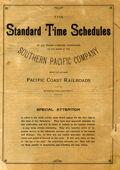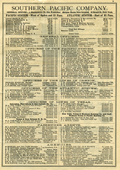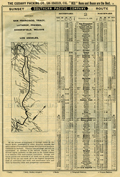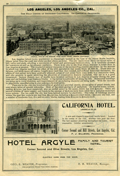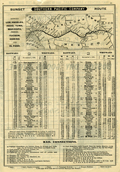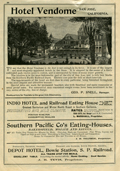|
|
Southern Pacific Company
The Standard Time Schedules
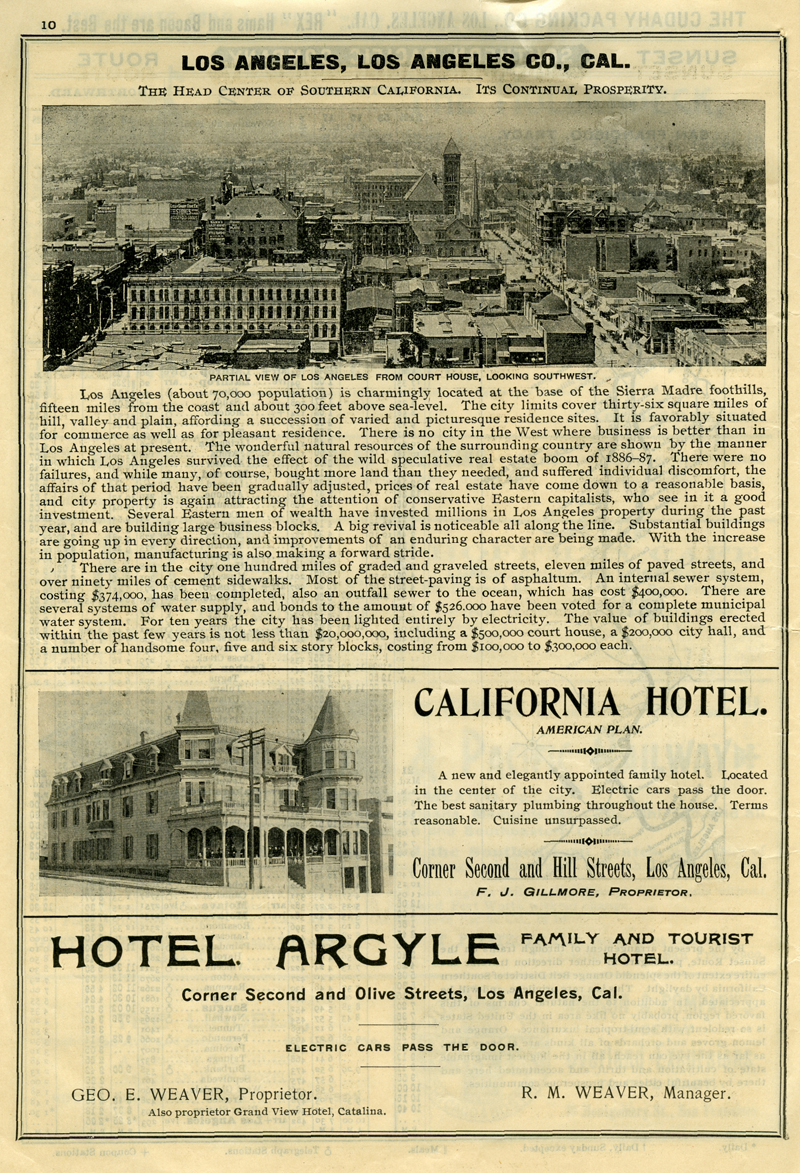
Click image to enlarge The Standard Time Schedules of All Trains Carrying Passengers on the Roads of the Southern Pacific Company and of Other Pacific Coast Railroads. Distributed Freely Each Month. November, 1895. Los Angeles, Los Angeles Co., Cal. "Los Angeles (about 70,000 population) is charmingly located at the base of the Sierra Madre foothills, fifteen miles from the coast and about 300 feet above sea-level. The city limits cover thirty-six square miles of hill, valley and plain, affording a succession of varied and picturesque residence sites. It is favorably situated for commerce as well as for pleasant residence. There is no city in the West where business is better than in Los Angeles at present. The wonderful natural resources of the surrounding country are shown by the manner in which Los Angeles survived the effect of the wild speculative real estate boom of 1886-87. There were no failures, and while many, of course, bought more land than they needed, and suffered individual discomfort, the affairs of that period have been gradually adjusted, prices of real estate have come down to a reasonable basis, and city property is again attracting the attention of conservative Eastern capitalists, who see in it a good investment. Several Eastern men of wealth have invested millions in Los Angeles property during the past year, and are building large business blocks. A big revival is noticeable all along the line. Substantial buildings are going up in every direction, and improvements of an enduring character are being made. With the increase in population, manufacturing is also making a forward stride. There are in the city one hundred miles of graded and graveled streets, eleven miles of paved streets, and over ninety miles of cement sidewalks. Most of the street-paving is of asphaltum. An internal sewer system, costing $374,000, has been completed, also an outfall sewer to the ocean, which has cost $400,000. There are several systems of water supply, and bonds to the amount of $526,000 have been voted for a complete municipal water system. For ten years the city has been lighted entirely by electricity. The value of buildings erected within the past few years is not less than $20,000,000, including a $500,000 court house, a $200,000 city hail, and a number of handsome four, five and six story blocks, costing from $100,000 to $300,000 each." From The History Channel website: One of the most powerful railroad companies of the 19th century, the "Espee" (as the railroad was often called) originated in an ambitious plan conceived in 1870 by the "Big Four" western railroad barons: Collis P. Huntington, Charles Crocker, Leland Stanford, and Mark Hopkins. A year earlier, the Big Four's western-based Central Pacific had linked up with the eastern-based Union Pacific in Utah, creating the first transcontinental American railway. With that finished, the "Big Four" began to look for ways to increase their control over West Coast shipping, and decided to focus their efforts on extending the California-based Southern Pacific southward. By 1877, the Southern Pacific controlled 85 percent of California's railroad mileage. Huntington, who now dominated the company, saw an excellent opportunity to create a transcontinental line through the southern United States. Huntington had to act fast if was to beat the competition. The Texas and Pacific Railroad was already pushing westward toward the Pacific at a fast pace. Marshalling his awesome energy and financial resources, Huntington began driving his Southern Pacific line eastward. He won the race in 1881, when he linked the Southern Pacific to the Santa Fe Railroad at Deming, New Mexico, creating the second American transcontinental railway. Two years later, on February 5, 1883, Huntington gained full control of a number of smaller railroads, creating the Southern Pacific's "Sunset Route" from New Orleans to California. With the "Sunset Route," Huntington confirmed his domination over California rails. He had taken considerable financial risks to build the Southern Pacific system, and he collected very considerable financial rewards. The Southern Pacific had a near monopoly over rail service to California, and Huntington and his associates took advantage of the situation by charging high shipping rates. Termed "the Octopus" for its tentacled stranglehold on much of the California economy, the Southern Pacific inspired Californians to create some of the first strong public regulations over railroads in American history. But despite the anger and outrage Huntington's exploitation inspired, few would deny that the mighty Southern Pacific Railroad played an essential role in fostering the growth of a vibrant California economy for decades to come.
AL1976e: 9600 dpi jpeg from scan of original pamphlet, collection of Alan Pollack. |
The site owner makes no assertions as to ownership of any original copyrights to digitized images. However, these images are intended for Personal or Research use only. Any other kind of use, including but not limited to commercial or scholarly publication in any medium or format, public exhibition, or use online or in a web site, may be subject to additional restrictions including but not limited to the copyrights held by parties other than the site owner. USERS ARE SOLELY RESPONSIBLE for determining the existence of such rights and for obtaining any permissions and/or paying associated fees necessary for the proposed use.
